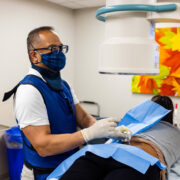
Back pain is an exceedingly common issue that affects hundreds of millions of people every year. Back pain does not always need to be a one-way ticket to lifelong discomfort or major surgery. Instead, the proper treatment and advice by orthopedic specialists can often return back-pain patients to their pain-free lives without any surgical intervention.
Among the most common types of back pain is sciatica. Affecting as many as 40% of people at some point during their life, sciatica is a pervasive source of discomfort that keeps people from living the active lives they want.
Thankfully, treatment for sciatica includes many noninvasive methods and success stories to back up such treatment. Read on to learn more about sciatica, how physical therapy can effectively manage sciatica pain, and some exercises to try as part of your treatment for sciatica.
What is Sciatica?
 Sciatica is a pain that radiates from the buttocks or lower back and down one leg. It results from an irritated sciatic nerve, the largest nerve in the human body. Getting as thick as a finger at points, the sciatic nerve branches out from the spine and then spreads down each leg.
Sciatica is a pain that radiates from the buttocks or lower back and down one leg. It results from an irritated sciatic nerve, the largest nerve in the human body. Getting as thick as a finger at points, the sciatic nerve branches out from the spine and then spreads down each leg.
Because of the size and location of the sciatic nerve, nerve-root entrapment and the subsequent pain it causes is very common. Whether the cause is a herniated disk, spinal stenosis, or inflammation of body parts next to the spine, tens of millions of people get diagnosed with sciatica every year.
Aside from young children, sciatica can affect people of all ages and body types. Regardless of who has sciatica, the symptoms are always the same and may include:
- Aching, dull, shooting, or burning pain that originates in your lower back or buttocks and moves down one leg
- Muscle weakness or compromised reflexes
- Numbness, tingling, or a pins-and-needles sensation in your leg
Effectively, back pain that solely resides in your back is likely not sciatica. However, any back pain accompanied by leg pain may be sciatica. In any case, we always recommend getting diagnosed by an orthopedic professional to ensure that you don’t do any harmful movements or delay the healing process.
Physical Therapy as Treatment for Sciatica
An individualized routine tailored to you, by an industry-leading specialist, can eliminate the need for painkilling drugs and save you from getting an invasive surgical procedure. At EmergeOrtho, we have extensive experience treating sciatica patients with conservative methods.
Physical therapy attempts to fix the underlying problems behind sciatica, such as poor joint movement, muscle coordination, or core weakness. Such issues don’t magically disappear with pain killers–they only get masked.
Before you try physical therapy for sciatica, we recommend seeing a health-care professional to diagnose your pain and a physical therapist who can tailor treatment to your needs. With that said, here are five common exercises that physical therapists may use as treatment for sciatica:
- Reclining pigeon pose: Pigeon poses are common in yoga and aim to open and loosen the hips. The reclining, forward, and sitting poses get progressively more challenging, so only move on to the next once you can comfortably hold the previous pose. To do the reclining pose, lie on your back, make a right angle with your left knee, clamp your hands around the back of your right thigh, and pull your right ankle onto your left knee.
- Forward pigeon pose: To do the forward pigeon pose, start by kneeling on all fours. Then, pick up your right leg and move it so that your right foot is in front of your left knee. Stretch your left leg behind you, then slowly shift your weight back to your legs until you feel a stretch.
- Sitting pigeon pose: Start by sitting down on the floor with your legs stretched in front of you. Bending your right leg, place your right ankle on top of your left knee. Then, lean forward until you feel a stretch.
- Standing hamstring stretch: With your right foot on the ground or a surface below hip level, bend your body forward and reach down toward your foot. Keep moving forward until you feel a stretch in the back of your leg.
- Sitting spinal stretch: Sit on the ground with your legs stretched out, bend your right knee, and move your right foot to the outside of your left knee. Then, place your left elbow outside your right knee and turn your body to the right.
You can perform the above exercises on both sides of your body by simply mirroring the instructions to your left side. However, we again stress that a physical therapist will ensure you get the best results for your time and effort, so do not hesitate to make an appointment.
If you think that you might have sciatica, or even if you have any other type of back pain, the orthopedic specialists and EmergeOrtho–Triangle Region have the knowledge and expertise your condition needs. We will always use conservative treatment methods whenever possible to avoid surgical intervention and the resulting pain and recovery process.
In addition, we will tailor a unique physical therapy for sciatic nerve pain treatment plan to ensure that you get the best outcomes in the most timely manner. If you want treatment for sciatica or other back pain, we encourage you to schedule an appointment. Or, call us any time at (919) 220-5255.







